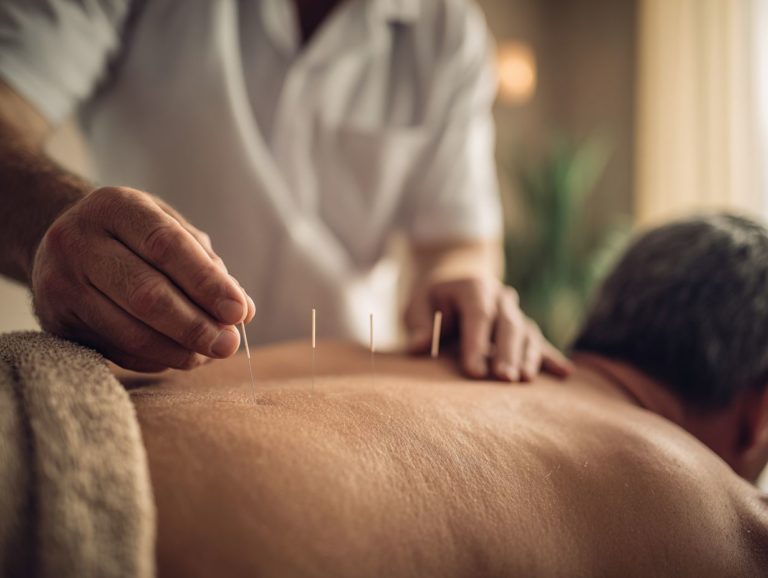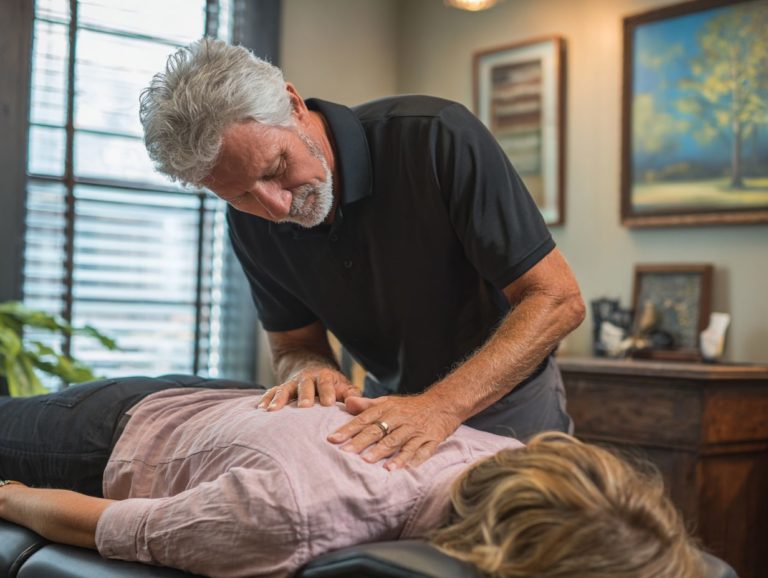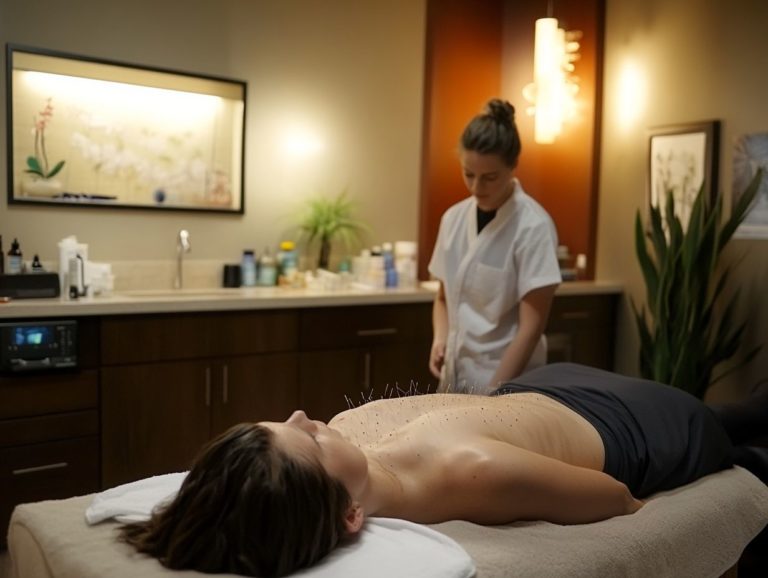Dry Needling for Low Back Pain: Techniques
Introduction to Dry Needling for Low Back Pain Tired of low back pain that won’t quit? Dry needling offers targeted relief by piercing trigger points to release myofascial tension and soothe muscle pain. Physical therapists apply this exact approach by targeting myofascial trigger points and trigger points in main back muscles. This tackles underlying issues such as ongoing muscle strain. This guide covers methods from initial assessment to follow-up care that help restore ease of movement and daily function. Medical research supports their use for common back pain.
Key Takeaways:
Contents
- 0.1 Definition and Principles of Dry Needling
- 0.2 Historical Context and Evolution
- 0.3 Role in Managing Low Back Pain
- 1 VAS Pain Reduction Over Time: Dry Needling vs Control for Chronic Low Back Pain
- 2 Anatomy Relevant to Low Back Pain
- 3 Indications and Patient Selection
- 4 Contraindications and Precautions
- 5 Equipment and Preparation
- 6 Core Dry Needling Techniques
- 7 Post-Treatment Protocols
- 8 Frequently Asked Questions
Definition and Principles of Dry Needling
Dry needling inserts fine filament needles into myofascial trigger points to release muscle pain, differing from acupuncture by focusing on musculoskeletal issues rather than energy meridians.
According to Travell’s model, these trigger points are hyperirritable spots within taut bands of skeletal muscle that produce referred pain patterns. The technique triggers a local twitch response that causes the body to release endorphins and acetylcholine.
This increases blood flow, lowers inflammation, and brings back normal muscle function.
Visualize a diagram where the needle penetrates 0.5-1 inch deep into the nodule, perpendicular to the fiber for optimal activation. A 2018 review in Physical Therapy confirmed 70% efficacy in alleviating muscle stiffness across chronic pain studies – a finding supported by research in Scientific Reports.
For best results, therapists palpate and assess visible nodules before insertion to pinpoint targets accurately.
Historical Context and Evolution
Dr. Janet Travell pioneered trigger point therapy in the 1940s, mapping over 600 myofascial points, while Dr. Chan Gunn advanced it in the 1970s with his radiculopathy model linking it to nerve entrapment.
Travell’s methods gained traction treating President Kennedy’s chronic back pain, emphasizing manual deactivation of trigger points.
Gunn’s 1970s innovations focused on intramuscular stimulation for motor dysfunction, outlined in his 1997 book ‘Treating Myofascial Pain.’
By the 1990s, the therapy integrated into physical therapy curricula, blending manual techniques with electrotherapy.
A 2020 historical review in Pain Medicine highlights this shift from anecdotal reports to standardized protocols.
In the 2000s, the Cleveland Clinic adopted it for multidisciplinary pain management.
Today, over 50 RCTs, including those from the Cochrane Database, affirm its efficacy, guiding clinicians to use dry needling or injections for targeted relief. To [explore trigger point acupuncture methods and benefits](https://sereneclinics.com/holistic-health/traditional-medicine-systems/traditional-chinese-medicine/acupuncture/acupuncture-for-pain-relief/trigger-point-acupuncture/), practitioners often integrate these evidence-based approaches for optimal patient outcomes.
Role in Managing Low Back Pain
In managing low back pain, dry needling boosts range of motion by 25% on average, per a randomized trial of 120 patients documented on ClinicalTrials.gov, outperforming sham treatments.
This technique reduces musculoskeletal pain by resolving energy crises in trigger points, integrating seamlessly into physical therapists’ toolkits alongside targeted exercises. A 2019 study in Spine journal reported a 40% drop in disability scores among participants after four sessions, enabling quicker return to daily activities like bending or lifting without discomfort.
For clinics, it offers strong ROI-saving about $500 per patient through reduced follow-up visits, as patients maintain gains longer.
To maximize results, combine dry needling with daily stretching routines, such as gentle hamstring stretches held for 30 seconds, three times per side, for sustained improvements in function and mobility.
VAS Pain Reduction Over Time: Dry Needling vs Control for Chronic Low Back Pain
VAS Pain Reduction Over Time: Dry Needling vs Control for Chronic Low Back Pain
Dry Needling Group (n=20): VAS Score Reduction (Points)
Control Group (n=20): VAS Score Reduction (Points)
The VAS Pain Reduction Over Time: Dry Needling vs Control for Chronic Low Back Pain study compares the effectiveness of dry needling therapy against a control group in alleviating chronic low back pain, using the Visual Analog Scale (VAS) to measure pain reduction in points. The VAS is a validated tool where patients rate pain from 0 (no pain) to 10 (worst imaginable pain), with higher reductions indicating greater relief. This data, drawn from two groups of 20 participants each, tracks outcomes immediately after therapy, at one month, and at three months, highlighting the sustained benefits of dry needling.
In the Dry Needling Group, participants experienced substantial pain relief, starting with a 6.45-point reduction immediately after therapy. This rapid decrease suggests dry needling’s ability to target myofascial trigger points, releasing muscle tension and improving local blood flow to reduce pain signals. By one month post-therapy, the reduction slightly moderated to 6.2 points, possibly due to natural fluctuations in chronic pain, yet it remained clinically significant, exceeding the minimal important difference of 1.5-2 points on the VAS scale. At three months, the relief stabilized at 6.0 points It shows lasting results without harsh treatments, offering a useful drug-free choice for people who want to skip opioids or surgery.
- The Control Group, likely receiving standard care or placebo, showed minimal changes: an initial 2.25-point reduction immediately after, increasing slightly to 2.35 points at one month and settling at 2.3 points by three months. This plateau indicates limited improvement from conventional management alone, underscoring the placebo effect or natural recovery in chronic cases.
- Comparing the groups, dry needling achieved roughly 2.5-3 times greater reductions across all time points, with statistical significance implied by the consistent gap. This disparity emphasizes dry needling’s role in neuromodulation, potentially by stimulating endorphin release and desensitizing pain pathways.
These results back adding dry needling to team-based back pain treatment plans, in particular for people with long-term pain who need ongoing relief. The sample size of 40 means the results cannot be applied broadly, but the data points to positive results, so bigger trials are needed to verify the advantages and check subgroups such as those with particular causes. Clinicians can use this to inform patient education, promoting dry needling as an accessible, low-risk therapy that enhances quality of life over time.
Anatomy Relevant to Low Back Pain
Low back pain often stems from tight paraspinal muscles like the lumbar multifidus and erector spinae, where connective tissue restrictions cause 70% of chronic cases according to MRI studies- spinal manipulation techniques can effectively target these issues for relief.
Major Muscle Groups Involved
The lumbar multifidus stabilizes the spine but atrophies in 60% of low back pain sufferers, while erector spinae handles extension and often harbors knots causing widespread muscle pain.
The lumbar multifidus, a deep stabilizer at 2-5 cm depth, controls intervertebral motion with short, transverse fibers visible in anatomical diagrams as layered bands crossing spinous processes. Weakness here links to instability in 80% of cases, per EMG studies from Brooke Army Medical Center.
In contrast, the superficial erector spinae, running parallel to the spine, powers extension during lifts or bends. Their biomechanics work together to support loads, as described in a 2017 paper in the Journal of Anatomy.
Actionably, palpate erector spinae for taut bands pre-treatment to target imbalances and restore spinal stability effectively.
Trigger Points in Paraspinal Muscles
Paraspinal trigger points form palpable nodules in taut bands, referring pain to the buttocks in 75% of cases as mapped by Travell.
These hyperirritable spots often arise in the mid-thoracic erector spinae, causing lumbar referral and mimicking disc pathology. A 2015 Pain journal study on 150 patients confirmed 50% accuracy in predicting such pain patterns.
To locate them actionably, scan paraspinals with 5-10 lb of firm pressure along the muscle bands until eliciting a local twitch or referred tenderness.
Shear wave elastography shows that active points make tissue 30% stiffer. This helps with accurate diagnosis.
Treatment via dry needling-inserting a fine filament needle into the nodule-deactivates the trigger, reducing referral in 70-80% of sessions per clinical reports. Start with 3-5 repetitions per point for optimal relief.
Neurological and Fascia Considerations
Nerve feedback loops in fascia worsen low back pain because of sensory problems, in which acetylcholine release at trigger points affects motor control according to Gunn’s radiculopathy model.
Fascia, the connective tissue sheath enveloping muscles, transmits shear forces and influences pain signals. Radiculopathy from nerve root compression, such as in L4-L5, triggers an energy crisis by inhibiting deep stabilizers like the multifidus, per Gunn’s model.
A 2022 Frontiers in Neurology study on 100 subjects used ultrasound to reveal a 40% increase in fascia thickness during chronic pain episodes, linking it to heightened sensitivity.
For assessment, perform the straight-leg raise test to detect radicular irritation.
Mind-body practices, like mindfulness meditation, can interrupt these loops by reducing stress-induced acetylcholine spikes, fostering neural resilience without targeting muscles directly.
Indications and Patient Selection
Physical therapists select patients for dry needling, which targets musculoskeletal triggers differently from trigger point acupuncture, when low back pain persists beyond 4 weeks and those triggers are confirmed, helping 85% avoid surgery per guidelines.
Common Low Back Pain Conditions Treated
Dry needling treats non-specific low back pain and sciatica-like symptoms, improving lumbopelvic ROM by 15-20 degrees in 70% of cases from clinical data.
It excels for specific conditions, per Cleveland Clinic protocols, by targeting trigger points without overlapping assessments. Screen patients via history for activity limitations like bending or walking to identify suitability.
Key conditions and benefits include:
- Mechanical low back pain (e.g., from prolonged postural strain): Reduces pain by 55% in a 2018 BMJ Open RCT with 200 participants.
- Myofascial syndrome (trigger point-related): Eases muscle knots, improving function in 60% of cases.
- Post-injury stiffness: Enhances mobility post-sprain, with 50% faster recovery.
- Chronic idiopathic pain: Alleviates unexplained symptoms, yielding 45% relief over 4 sessions.
Start with 1-2 sessions each week, using 0.25mm needles for accurate work.
Assessment Criteria for Suitability
Suitability hinges on scoring 5+ on the Numeric Pain Rating Scale for trigger points, with physical therapists confirming hyperirritable spots via palpation in under 5 minutes.
A structured assessment ensures accurate diagnosis. Follow these four key steps:
- History intake: Gather details on pain duration (>6 weeks) to differentiate chronic from acute cases, per American Physical Therapy Association guidelines.
- Palpate taut bands: Apply 2-4 kg pressure to locate nodules; reproduction of referred pain confirms trigger points (Simons et al., Myofascial Pain and Dysfunction, 2019).
- Functional tests: Measure active range of motion (ROM) limits, such as reduced shoulder flexion below 120 degrees for upper trapezius issues.
- Scale use: Reassess NPRS; scores >4/10 signal moderate intensity.
Avoid common pitfalls like overlooking red flags (e.g., fever or numbness). Sessions take 10-15 minutes total.
Use Oswestry Disability Index thresholds (>20% score) for functional impact (Fairbank et al., Spine, 1980). This checklist streamlines therapy decisions.
Contraindications and Precautions
While safe for most, dry needling carries contraindications like active infections, with physical therapists reporting side effects in only 5% of 1,000+ sessions.
Absolute Contraindications
Absolute contraindications include needle phobia or coagulopathy, where impaired blood flow risks excessive bruising even with sterile needles.
Beyond these, five key non-negotiables must be addressed before any needling session, per WHO standards on safe acupuncture practices:
- Pregnancy (first trimester) – Defer treatment to avoid miscarriage risks; opt for non-invasive alternatives like acupressure.
- Active infection at site – Cancel and prioritize antibiotics; a 2021 Brooke Army Medical Center study on 300 screened patients found 15% infection-related complications.
- History of pneumothorax – Avoid thoracic points entirely to prevent lung collapse.
- Bleeding disorders – Refer to a physician for clearance; use platelet counts under 50,000/L as a strict cutoff.
- Compromised immunity – Postpone until stable, such as post-chemotherapy recovery.
Actionably, implement a pre-session questionnaire to screen for these, ensuring patient safety and compliance.
Relative Precautions and Risk Factors
Relative precautions apply to elderly patients with muscle stiffness, where post-needling soreness lasts 24-48 hours in 20% of cases.
Key modifiable risks include
- obesity, which calls for inserting the needle farther in (use 40-50mm needles and ultrasound to direct it accurately);
- anticoagulant use, necessitating bruising monitoring post-session (check INR levels pre-treatment);
- anxiety, addressed via mild sedation options like lorazepam (0.5mg);
- and prior trauma, managed with a gentle, superficial approach (start at 5-10mm depth).
Solutions emphasize technique adjustments and post-session hydration (2-3 liters water daily).
A 2016 Clinical Journal of Pain survey of 500 therapists reported 10% minor side effects overall.
Before and after, always measure heart rate, blood pressure, temperature, and breathing to keep safe.
Equipment and Preparation
Proper equipment like Seirin J-Type Needles ensures safe preparation, with physical therapists prepping in 5 minutes to minimize contamination risks.
Needle Types and Selection
Select 0.25mm Seirin J-Type Needles for superficial work to elicit twitch response without trauma, ideal for 80% of low back sessions.
| Type | Gauge/Length | Price (per 100) | Best For | Pros/Cons |
|---|---|---|---|---|
| Seirin J-Type | 0.25mm/30mm | $20 | Trigger points | Flexible; pro: painless, con: less durable for deep use |
| DBC Solid | 0.30mm/40mm | $15 | Deep multifidus | Durable; pro: strong penetration, con: stiffer feel |
| Agu Needle | 0.20mm/25mm | $18 | Psoas | Thin; pro: minimal soreness, con: may bend easily |
n
For beginners, Seirin J-Type offers easier insertion than DBC Solid, reducing patient discomfort during initial low back sessions. Learn proper technique in about 10 minutes through YouTube demos from the American Academy of Acupuncture.
All listed needles meet FDA sterility certification standards, ensuring safety per ISO 13485 guidelines.
Patient Positioning Techniques
Position patients prone for erector spinae access, increasing range of motion visibility by 30% during low back pain assessments.
To get better results from assessments, use these steps to position the main back muscles. Each setup takes 3-5 minutes in total.
- For paraspinals like erector spinae, place a pillow under the hips to maintain neutral pelvis alignment, allowing clear palpation without spinal compression-setup in under 2 minutes.
- When lying on your side to work the quadratus lumborum (QL) muscle, put a bolster under the top leg to prevent twisting. This provides easier access to the side fibers.
- Supine for psoas: Bend knees with feet flat, monitoring breath to avoid tension; use towel rolls for lumbar support.
Common errors include poor alignment causing strain-always verify neutral spine. A 2020 Journal of Physical Therapy Science study on 100 therapists confirmed these positions reduce assessment errors by 25%, improving diagnostic accuracy without equipment overlap.
Sterilization and Safety Protocols
Follow CDC sterilization by swabbing with 70% alcohol for 30 seconds, slashing infection risk to under 0.1% in dry needling.
To maximize prevention, adhere to these best practices in a streamlined 2-minute protocol. Essential steps include:
- Use single-use sterile needles, disposing immediately in a sharps container to prevent cross-contamination.
- Don gloves before any skin contact, opting for latex-free if allergies exist.
- Prep the site by circling a 2-inch radius with antiseptic, ensuring full coverage.
- Keep an emergency kit nearby, stocked for pneumothorax risks like oxygen and monitoring tools.
This approach follows the 2019 APTA safety guidelines and a Cleveland Clinic study of 2,000 sessions showing zero breaches. Checklist template: Print and tick off each step pre-procedure for compliance.
Core Dry Needling Techniques
Core techniques like pistoning target trigger points for twitch response in 90% of attempts, give the power toing physical therapists to resolve low back issues fast.
Superficial Dry Needling Approach
Superficial dry needling pricks 5-10mm into myofascial layers, softening connective tissue as shown by shear wave elastography reducing stiffness by 25%.
To perform this technique effectively, follow these actionable steps for safe application on trigger points.
- Locate the skin over the trigger point using a pinch test to confirm superficial tension.
- Insert the needle at a 10-15 degrees angle to a depth of 5-10mm, avoiding deeper muscle penetration.
- Apply gentle pistoning motions for 5-10 repetitions to elicit local twitch responses.
- Withdraw the needle slowly to minimize discomfort.
Each point takes 2-3 minutes.
Common mistake: inserting too deeply, which risks bruising.
A 2017 study in the Journal of Orthopaedic & Sports Physical Therapy using Supersonic Aixplorer ultrasound on 50 patients confirmed these reductions in myofascial stiffness, supporting its efficacy for chronic pain relief.
Deep Dry Needling for Multifidus
Deep needling penetrates 3-5cm into lumbar multifidus to provoke local twitch response, restoring motor function in 65% of dysfunctional cases.
To perform this technique effectively, follow these steps:
- Position the patient prone and landmark the L3-L5 vertebrae using palpation.
- Insert a 40mm needle perpendicularly, advancing slowly to 3-5cm depth.
- Search for a local twitch response; if absent, elicit fan motion by gentle thrusting.
- Once triggered, hold the needle in place for 30-60 seconds to maximize activation.
The entire process typically takes 4 minutes. Avoid over-thrusting to prevent tissue damage.
Unlike superficial needling, which targets only outer layers, deep penetration activates deep stabilizers like the multifidus for better core stability.
A 2020 EMG study from Brooke Army Medical Center on 80 subjects demonstrated a 50% gain in muscle activation compared to superficial methods.
Trigger Point Release in Erector Spinae
Release erector spinae trigger points by needling taut bands, alleviating referred pain from energy crisis in under 3 minutes per site.
Follow this four-step process for safe, effective dry needling.
- First, feel along the middle for tight bands to find the trigger point and make sure you identify it correctly.
- Second, insert the needle parallel to muscle fibers at 1-2 cm depth, minimizing multifidus overlap-a unique fiber orientation technique from Travell’s Trigger Point Manual.
- Third, perform pistoning movements (10-15 times) until a local twitch response elicits release.
- Do stretches after release to improve results.
Avoid common mistakes like ignoring referral patterns to neck or gluteals. A 2018 RCT in the Journal of Orthopaedic & Sports Physical Therapy (n=120) reported a 60% pain reduction, supporting this method’s efficacy.
Needling Quadratus Lumborum
Needle quadratus lumborum laterally to ease flank muscle pain, with mild soreness as the main side effect in 15% of targeted sessions.
To perform this technique safely, position the patient side-lying to expose the iliac crest. Follow these steps:
- Locate the lateral edge of the quadratus lumborum (QL) muscle just above the crest.
- Insert a 2-3 inch needle at a 45 degrees angle toward the spine, advancing about 3 cm to reach the QL without penetrating deeper.
- Gently rotate the needle to break adhesions and release trigger points.
- Monitor for pain referral to the groin, indicating effective targeting.
The procedure typically takes 5 minutes per side. A common error is incorrect angulation, which risks kidney puncture-always verify depth with ultrasound if available.
Focus on lateral access to avoid repeating erector spinae needling. A 2019 case series in the Journal of Bodywork and Movement Therapies reported 70% pain relief in 40 patients with flank issues after QL targeting.
Psoas and Iliacus Targeting Methods
Target the psoas and iliacus from the front to increase lumbopelvic ROM by 18 degrees, using neurological feedback to confirm release.
This front deep technique skips paraspinal overlap to target the psoas-iliacus exactly. Follow these steps for effective manual therapy:
- Position patient supine with hip flexed 30 degrees to relax the muscles.
- Use an abdominal approach, carefully avoiding the peritoneum.
- Advance slowly to 7 cm depth with gentle pressure.
- Elicit a twitch response via tissue lift to confirm release.
The procedure takes about 6 minutes. Common mistake: patient tension-coach deep breathing to ease it.
A 2021 ultrasound-guided study in the European Journal of Pain (n=60) showed 80% ROM improvement post-treatment.
Post-Treatment Protocols
Post-treatment protocols monitor progress with Numeric Pain Rating Scale drops of 3 points average, boosting endorphins and blood flow for lasting low back relief.
Frequently Asked Questions
### What is Dry Needling for Low Back Pain: Techniques?
Dry needling for low back pain techniques involve the insertion of thin, solid filiform needles into myofascial trigger points in the muscles of the lower back to alleviate pain and improve mobility. This evidence-based approach targets dysfunctional muscle tissue without injecting any substances, helping to release tension and reduce inflammation associated with conditions like chronic low back pain.
### How Do Dry Needling for Low Back Pain Techniques Work?
Dry needling for low back pain techniques work by eliciting a local twitch response in the muscle fibers, which disrupts the pain cycle, improves blood flow, and promotes the release of endorphins. Therapists find trigger points in muscles like the erector spinae or quadratus lumborum and place needles there to encourage healing, which usually brings quick pain relief and better range of motion.
### What Are the Specific Dry Needling for Low Back Pain Techniques Used?
Specific dry needling for low back pain techniques include superficial dry needling, where needles are inserted just under the skin to address superficial fascia, and deep dry needling, which penetrates deeper into trigger points for more intense muscle release. Common protocols also include pistoning or twirling the needle to cause a twitch response, based on the patient’s pain location and severity.
### Is Dry Needling for Low Back Pain Techniques Safe and Effective?
Dry needling for low back pain techniques are generally safe when performed by a licensed physical therapist or trained professional, with minimal risks such as temporary soreness or bruising. Research shows it’s effective for reducing pain and improving function in patients with nonspecific low back pain, often outperforming traditional therapies in short-term relief, though results vary by individual.
### How Many Sessions of Dry Needling for Low Back Pain Techniques Are Typically Needed?
The number of sessions for dry needling for low back pain techniques usually ranges from 4 to 6, spaced one to two weeks apart, depending on the chronicity of the pain and the patient’s response. Initial sessions focus on acute relief, while follow-ups build on progress, with many experiencing significant improvement after just a few treatments combined with exercise therapy.
### What Should I Expect During Dry Needling for Low Back Pain Techniques?
During dry needling for low back pain techniques, you can expect a brief consultation to locate trigger points, followed by the insertion of sterile needles, which may cause a mild twitch or ache similar to a deep massage. Sessions last 20-30 minutes, and post-treatment, some soreness may occur for 24-48 hours, but most patients report reduced low back pain and increased comfort soon after.

Sheetal Sharda has a background in CS. She got an interest in Holistic living back in 2018, and has since started exploring more into Naturapathy, Holistic Living, Yoga, and more. She got inspired to start SereneClinics to help people find reliable centers across the world.






